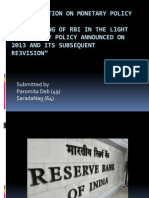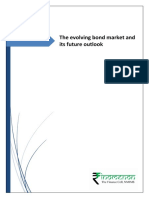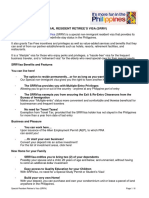Monetary Pol
Monetary Pol
Uploaded by
st1dCopyright:
Available Formats
Monetary Pol
Monetary Pol
Uploaded by
st1dCopyright
Available Formats
Share this document
Did you find this document useful?
Is this content inappropriate?
Copyright:
Available Formats
Monetary Pol
Monetary Pol
Uploaded by
st1dCopyright:
Available Formats
Gunjan Agrawal, 1st Sem
Monetary policy is the process by which the government, central bank, or monetary authority of a country
controls (i) the supply of money, (ii) availability of money, and (iii) cost of money or rate of interest, in order
to attain a set of objectives oriented towards the growth and stability of the economy. Monetary theory
provides insight into how to craft optimal monetary policy.
Statutory Liquidity Ratio : Statutory Liquidity Ratio or SLR refers to the amount that all banks require to
maintain in cash or in the form of Gold or approved securities. The SLR is commonly used to
contain inflation and fuel growth, by increasing or decreasing it respectively. This counter acts by decreasing
or increasing the money supply in the system respectively.
Cash reserve Ratio (CRR) is the amount of funds that the banks have to keep with RBI. If RBI decides to
increase the percent of this, the available amount with the banks comes down. RBI is using this method
(increase of CRR rate), to drain out the excessive money from the banks. With the hike in CRR, the
prospective borrower is hit the worst, because of higher interest rates.
Bank rate is the rate at which RBI gives to the commercial banks. Whenever RBI increases its rates, the
effect will be shown on the commercial banks. In this case, the commercial banks have to increase the
interest rates for their profits.
Repo rate : Whenever the banks have any shortage of funds they can borrow it from RBI. Repo rate is the
rate at which our banks borrow rupees from RBI. A reduction in the repo rate will help banks to get money at
a cheaper rate. When the repo rate increases borrowing from RBI becomes more expensive.
Reverse Repo : It is the rate at which the RBI borrows from banks. Banks are always happy to lend money
to RBI since their money are in safe hands with a good interest. An increase in Reverse repo rate can cause
the banks to transfer more funds to RBI due to this attractive interest rates. It can cause the money to be
drawn out of the banking system.
Rates:
Raises statutory liquidity ratio by 100 bps to 25%
Keeps other key rates unchanged
Repo rate retained at 4.75%; reverse repo at 3.25%
Cash Reserve Ratio kept at 5%
Gunjan Agrawal, 1st Sem
Bank Rates same at 6%
Provisioning requirement for realty up at 1% from 0.40%
Growth:
Retains GDP growth projection for FY'10 at 6%
Weak monsoon can impact overall economic prospects
Poor farm output may affect industrial and services sectors
Industrial production may revive further in coming months
Growth in trade-related services such as cargo decelerating
Domestic services communication, construction turning up
Direct impact of fiscal stimulus waning
Indirect impact will persist for some more time
External demand remains weak, hitting exports.
Inflation:
Ups inflation projection to 6.5% pc by March-end, from 5%
Aims to contain inflation at 4-4.5%
Prices of food items risen due to short supply
Large increase seen in prices of vegetables, sugar, etc
Asset prices like stocks, realty, commodity have risen sharply
Others:
Managing large govt borrowings a major challenge for RBI
Non-food bank credit declines sharply
Gunjan Agrawal, 1st Sem
Non-bank credit to commercial sector turning around
Credit flow to agri, real estate, NBFCs remain high.
Credit flow to housing low
Implications
The status quo on policy rates would anchor interest rate expectations that could spur investment demand.
There are signs of revival in the domestic economy and credit demand is expected to pick up.
The large domestic demand bolstered by the government consumption, provision of forex and rupee liquidity
coupled with sharp cuts in policy rates, a sound banking sector and well-functioning financial markets helped
cushion the economy from the worst impact of the crisis. There are now progressive signs of recovery in
India: food stocks have increased; industrial production has turned positive; corporate performance has
improved; business confidence surveys are optimistic; leading indicators show an upturn; interest rates have
declined; credit off-take has picked up after May 2009; stock prices have rebounded; the primary capital
market has witnessed some activity; and external financing conditions have improved. On the other hand,
there are some negative signs: delayed and deficient monsoon; food price inflation; rebound in global
commodity prices; continuing weak external demand; and high fiscal deficit.
Liquidity is up. Rupee liquidity, dollar liquidity.
Because of ample liquidity, the pressure on banks to reduce lending rates has increased.
The stance of monetary policy is to:
* Manage liquidity actively so that the credit demand of the Government is met while ensuring the flow of
credit to the private sector at viable rates.
* Keep a vigil on the trends and signals of inflation, and be prepared to respond quickly and effectively
through policy adjustments.
* Maintain a monetary and interest rate regime consistent with price stability and financial stability supportive
of returning the economy to the high growth path.
You might also like
- A Project Synopsis On Portfolio ManagementDocument7 pagesA Project Synopsis On Portfolio ManagementSanthoshiNo ratings yet
- Medusa Mining Limited ProspectusDocument313 pagesMedusa Mining Limited ProspectusBilly LeeNo ratings yet
- Maryam Nawaz Annex B - (Assets Beyond Means - Other Respondents)Document1 pageMaryam Nawaz Annex B - (Assets Beyond Means - Other Respondents)سچ ٹی ویNo ratings yet
- Economy and Finance deDocument5 pagesEconomy and Finance deNischal SolankiNo ratings yet
- Impt. For AsignmentDocument4 pagesImpt. For AsignmentPranshu_Priyad_8742No ratings yet
- RBI Raised Interest Rates How This Impacts You!Document5 pagesRBI Raised Interest Rates How This Impacts You!Aishwarya ShettyNo ratings yet
- Tathya Ashish Isb HyderabadDocument4 pagesTathya Ashish Isb HyderabadAshish KumarNo ratings yet
- Key Highlights:: Inflationary Pressures Overrides Downside Risks To GrowthDocument6 pagesKey Highlights:: Inflationary Pressures Overrides Downside Risks To Growthsamyak_jain_8No ratings yet
- Monetary PolicyDocument18 pagesMonetary PolicySarada NagNo ratings yet
- Indian Monetary Policy Analysis (2010-2017)Document38 pagesIndian Monetary Policy Analysis (2010-2017)Parang Mehta95% (21)
- Rbi Monetary PolicyDocument5 pagesRbi Monetary PolicyRohit GuptaNo ratings yet
- Submitted By-Arpita Shukla Sec ADocument18 pagesSubmitted By-Arpita Shukla Sec AAshish ShuklaNo ratings yet
- Monetary Policy of IndiaDocument6 pagesMonetary Policy of IndiaSOURAV SAMALNo ratings yet
- Why Interest Rates ChangeDocument4 pagesWhy Interest Rates Changekirang gandhiNo ratings yet
- Monetory PolicyDocument21 pagesMonetory Policyharikrishna k sNo ratings yet
- RBI Monetary Policy UpdateDocument12 pagesRBI Monetary Policy UpdateSai KarthickNo ratings yet
- Monetary Policy ReviewsDocument6 pagesMonetary Policy ReviewspundirsandeepNo ratings yet
- Repo RateDocument5 pagesRepo RateSweta SinghNo ratings yet
- Monetary Policy of India - WikipediaDocument4 pagesMonetary Policy of India - Wikipediaambikesh008No ratings yet
- Business Environment PoliciesDocument7 pagesBusiness Environment PoliciesmandeepNo ratings yet
- Monetary PolicyDocument39 pagesMonetary PolicyTirupal PuliNo ratings yet
- RBI Hikes Repo Rate For First Time in Four Years by Kapil KathpalDocument31 pagesRBI Hikes Repo Rate For First Time in Four Years by Kapil Kathpal32divyanshuNo ratings yet
- Assignment of Buisness Enviroment MGT 511: TOPIC: Changes in Monetary Policy On Banking Sector or IndustryDocument9 pagesAssignment of Buisness Enviroment MGT 511: TOPIC: Changes in Monetary Policy On Banking Sector or IndustryRohit VermaNo ratings yet
- Monetary Policy - IndicatorsDocument4 pagesMonetary Policy - IndicatorsGJ RamNo ratings yet
- Monetary and Fiscal PoliciesDocument27 pagesMonetary and Fiscal PoliciesEkta SuriNo ratings yet
- RBI Q3 Monetory PolicyDocument9 pagesRBI Q3 Monetory Policydeepakambulkar8166No ratings yet
- C O M P A N Y P R O F I L E: Achal Gupta Managing Director & Chief Executive OfficerDocument61 pagesC O M P A N Y P R O F I L E: Achal Gupta Managing Director & Chief Executive OfficervipinkathpalNo ratings yet
- Fiscal and Monetary PolicyDocument17 pagesFiscal and Monetary Policyrajan tiwari100% (1)
- 1.1 Monetary PolicyDocument77 pages1.1 Monetary PolicyS SrinivasanNo ratings yet
- Inflation No MonetaryDocument2 pagesInflation No MonetaryprokashmondalNo ratings yet
- Evolving Bond MarketDocument9 pagesEvolving Bond MarketcoolNo ratings yet
- Monetary PolicyDocument18 pagesMonetary PolicyTanmay JainNo ratings yet
- Monetary Policy Is of Two KindsDocument16 pagesMonetary Policy Is of Two KindsSainath SindheNo ratings yet
- Monetary Policy - 123Document4 pagesMonetary Policy - 123Hitesh SehgalNo ratings yet
- Review of Monetary Policy Statement H2'24 by EBLSLDocument7 pagesReview of Monetary Policy Statement H2'24 by EBLSLAnika Nawar ChowdhuryNo ratings yet
- What Is Monetary Policy?Document13 pagesWhat Is Monetary Policy?meghakharkwalNo ratings yet
- Concept Monetary and Fiscal PolicyDocument17 pagesConcept Monetary and Fiscal Policycluadine dineros100% (1)
- Rbi Monetary Policy 2011-2012 and It'S Impact On IndividualsDocument4 pagesRbi Monetary Policy 2011-2012 and It'S Impact On IndividualsBernard EkkaNo ratings yet
- Fiscal and Monetary PolicyDocument17 pagesFiscal and Monetary PolicySuresh Sen100% (2)
- RBI Credit PolicyDocument1 pageRBI Credit Policysangya01No ratings yet
- RBI Annual Monetary Policy 2010Document6 pagesRBI Annual Monetary Policy 2010Komal NarayanNo ratings yet
- Banking Case StudyDocument9 pagesBanking Case Studyainesh_mukherjeeNo ratings yet
- Macroeconomics Case Analysis On "Trend and Reasons For RBI Credit Policy" byDocument4 pagesMacroeconomics Case Analysis On "Trend and Reasons For RBI Credit Policy" bySandeep SheshamNo ratings yet
- Entrepreneurship Managementt200813Document7 pagesEntrepreneurship Managementt200813Arpita SrivastavaNo ratings yet
- FixedIncome January 2012Document3 pagesFixedIncome January 2012jayaram_mca83No ratings yet
- Business Ethics AND Corporate Governance: TopicDocument7 pagesBusiness Ethics AND Corporate Governance: TopicJohn PrarthanNo ratings yet
- Monetary PolicyDocument6 pagesMonetary Policymonil_kNo ratings yet
- Documentation Economics DiscussionDocument3 pagesDocumentation Economics DiscussionAnonymous m9qH6435GNo ratings yet
- Monetary and Fiscal Policy (Final)Document27 pagesMonetary and Fiscal Policy (Final)nohel01100% (1)
- Assignment of Managerial Economics: Topic:Steps Taken by RBI To Control InflationDocument7 pagesAssignment of Managerial Economics: Topic:Steps Taken by RBI To Control Inflationliyakat_khanNo ratings yet
- Slide - 1: 2009. Between March 2010 and October 2011 The Reserve Bank Raised Its Policy RepoDocument3 pagesSlide - 1: 2009. Between March 2010 and October 2011 The Reserve Bank Raised Its Policy RepoGarrima ParakhNo ratings yet
- Macro Economics and Business Environment Assignment: Submitted To: Dr. C.S. AdhikariDocument8 pagesMacro Economics and Business Environment Assignment: Submitted To: Dr. C.S. Adhikarigaurav880No ratings yet
- Central Bank & Monetary Policy - 1Document30 pagesCentral Bank & Monetary Policy - 1Dr.Ashok Kumar PanigrahiNo ratings yet
- RBI Policy Terms For Aam AadmiDocument2 pagesRBI Policy Terms For Aam AadmiSPIMYSNo ratings yet
- Market Insight Q3FY12 RBI Policy Review Jan12Document3 pagesMarket Insight Q3FY12 RBI Policy Review Jan12poojarajeswariNo ratings yet
- Monetary Policy and Reform: T1 AssignmentDocument8 pagesMonetary Policy and Reform: T1 AssignmentShafqat AliNo ratings yet
- Economics Banking ProjectDocument15 pagesEconomics Banking ProjectCJKNo ratings yet
- Monetary PolicyDocument22 pagesMonetary Policykhatiwada2005No ratings yet
- Monetary and Fiscal Policies in IndiaDocument5 pagesMonetary and Fiscal Policies in Indiarakeshgopinath4999No ratings yet
- Monetary Policy and Role of Banks: February 2015Document7 pagesMonetary Policy and Role of Banks: February 2015anik24No ratings yet
- The Power to Stop any Illusion of Problems: (Behind Economics and the Myths of Debt & Inflation.): The Power To Stop Any Illusion Of ProblemsFrom EverandThe Power to Stop any Illusion of Problems: (Behind Economics and the Myths of Debt & Inflation.): The Power To Stop Any Illusion Of ProblemsNo ratings yet
- Asian Development Outlook 2015: Financing Asia’s Future GrowthFrom EverandAsian Development Outlook 2015: Financing Asia’s Future GrowthNo ratings yet
- 03 - Strategic OutsourcingDocument20 pages03 - Strategic OutsourcingTay KittithatNo ratings yet
- Jawapan Strategic Management Ass2Document31 pagesJawapan Strategic Management Ass2kiranaomom100% (1)
- Principle and Practice of TaxationDocument5 pagesPrinciple and Practice of TaxationAgyeiNo ratings yet
- MAGML Q3 Accounts For The Period 31.03.2022Document2 pagesMAGML Q3 Accounts For The Period 31.03.2022shoyeb rakibNo ratings yet
- Q Ratio - Tobin's Q DefinitionDocument8 pagesQ Ratio - Tobin's Q DefinitionCharlotte MartinNo ratings yet
- Gaim Usa 2012Document20 pagesGaim Usa 2012mcampuzaNo ratings yet
- Final Accounts NotesDocument6 pagesFinal Accounts NotesVinay K TanguturNo ratings yet
- Importantquestion of B.com Part 1Document3 pagesImportantquestion of B.com Part 1sufyanbutt007100% (2)
- Acc208 Tutorial 5Document2 pagesAcc208 Tutorial 5lawerence0% (1)
- Time Value of Money: All Rights ReservedDocument55 pagesTime Value of Money: All Rights Reservedjaz hoodNo ratings yet
- Financial Statements Analysis - ComprehensiveDocument60 pagesFinancial Statements Analysis - ComprehensiveGonzalo Jr. RualesNo ratings yet
- Sachdevajk, Journal Manager, 5-4-3 - Sumeet-1Document26 pagesSachdevajk, Journal Manager, 5-4-3 - Sumeet-1Parth DongaNo ratings yet
- Bank FormDocument3 pagesBank Formgeemanig100% (1)
- Bank Strategic Planning and Budgeting ProcessDocument18 pagesBank Strategic Planning and Budgeting ProcessBaby KhorNo ratings yet
- 5466 9322 1 PBDocument16 pages5466 9322 1 PBdelian verrelNo ratings yet
- Nepal TaxationDocument19 pagesNepal TaxationVijay AgrahariNo ratings yet
- Master of AccountingDocument5 pagesMaster of AccountingPhilip CastroNo ratings yet
- Special Resident Retirees Visa SRRV InfoDocument6 pagesSpecial Resident Retirees Visa SRRV InfoMary Heide H. AmoraNo ratings yet
- Old Companies Ordinance Cap 32 PDFDocument392 pagesOld Companies Ordinance Cap 32 PDFSinoNo ratings yet
- BBA 2002 Principle of MicroeconomicsDocument17 pagesBBA 2002 Principle of MicroeconomicsVentusNo ratings yet
- Trading Strategies - LiteFinanceDocument13 pagesTrading Strategies - LiteFinancejmwallohNo ratings yet
- Linear Programming: Modeling Examples: BJQP 2023 Management ScienceDocument15 pagesLinear Programming: Modeling Examples: BJQP 2023 Management ScienceLola CarolinaNo ratings yet
- State Rep. Mindy Domb 2018 SFIDocument13 pagesState Rep. Mindy Domb 2018 SFIDusty ChristensenNo ratings yet
- 1.1 - 1.4 Risk and Return, Bonds, StockDocument227 pages1.1 - 1.4 Risk and Return, Bonds, StockScotty ScottNo ratings yet
- Project ReportDocument43 pagesProject ReportsoumyaNo ratings yet
- Determining The Context of The Organization in ISO 14001Document5 pagesDetermining The Context of The Organization in ISO 14001Made YennyNo ratings yet
- Minority InterestDocument1 pageMinority Interestankur4042007No ratings yet

























































































